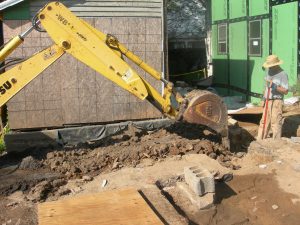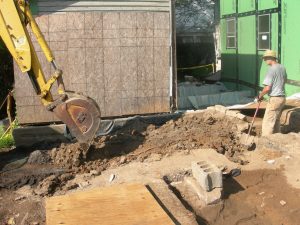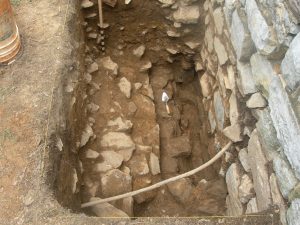After the summer dust settled, we had Rivanna Archaeological Services return on the 8th of August to finish their work at the site for this year. This time they were joined by the other principal of the firm, Benjamin Ford, PhD, in addition to Steve Thompson and Nick Bon-Harper, who previously worked with us in June. Ben and Nick focused on the two test units in the front of the stone side of the house where there was once a bulkhead opening to the basement of that original part of the structure. At the same time Steve Thompson, who had led the principle phase of Rivanna’s excavations in June, worked with Executive Director & Curator Byron Smith in the rear yard behind the log side. There in the area behind the log side of the house Steve supervised our volunteer, Mr. Dick Sandy, who operated his backhoe loader to strip away some of the fill dirt over the kitchen site, and regrade the surface behind the house to facilitate drainage. (See images below.)


Part of this job involved filling in holes and a trench that had previously been dug by museum staff to uncover the old bathroom plumbing and sewer line. This infill work was done to prevent erosion which could threaten the stratigraphy of future archeology at the site. The area behind the log side is now prepared until the next time we employ Rivanna to come back and finish the next phase of the work. That final phase will involve completely uncovering the remaining foundation walls and the floor of the kitchen so that we will be able to make a plan to reconstruct that structure.
Meanwhile, in the front of the stone side of the house, Ben and Nick completed the excavation of the two test units to expose the original eighteenth century stone stairs that formerly gave access to the cellar under the stone side of the house. (See photo below.)

Our purpose in studying these two units was to discover (if possible) the time period when this bulkhead doorway was closed off. This could hopefully be accomplished by examining the artifacts that came out of the undisturbed soil that was used to backfill the stairwell after the bulkhead was closed off. In theory, discovering artifacts dating to the period after the 1830s would indicate that this bulkhead opening would likely have been there in the year 1830, which is the target date of our restoration of the house. The challenge associated with these two test units was in the way they had been disturbed by previous activity. During the mid-twentieth century a water line was installed and a pipe was laid in a trench where we excavated the south test unit. (This pipe is visible in the photo above.) Later in the twentieth century we set our museum’s street sign in a posthole next to the water line. Thus, the majority of the soil coming out of the top layers of these units was useless for our purposes. We can only reasonably assume that the very bottom soil at the base of the stone stairs was undisturbed. The artifacts discovered therein at the bottom of the stairs should tell us if the bulkhead was filled in after 1830. Rivanna staff are processing those artifacts now. We hope to have the results of their study by the end of the year. We will let you know those results and other news in the next posts.
